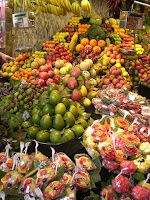Being an orchid grower and a perfumer sometimes leads to
strange experiences and gives me new names to describe what I smell in the
greenhouse and the lab using crossover terminology from each area. I recently
had the experience of encountering a familiar smell in an unexpected context.
I think I’ll start the story on the perfumery end with a
material called Fructalate, also known as raspberry dicarboxylate or diethyl
cyclohexane-1,4-dicarboxylate. It’s a common aroma chemical, manufactured by a
number of different companies. The official description is, “fruity, raspberry,
apple, ethereal … a long-lasting fruity, berry note which is powerful,
affordable, and stable”. To me it doesn’t smell like raspberries, but it
certainly is long-lasting, powerful and “affordable”, which is a euphemism for cheap.
A couple of years ago I bought a few kilos of the stuff as a
favor to an overseas colleague who couldn’t get it locally. I split it with a
few others and kept a little for myself “just in case”. In the process of
pouring it from the big container into smaller ones for shipping, a little bit
spilled on the bare wooden table where I do this sort of work and where I pack
plants to ship. For the first year the smell on the table was quite noticeable
all the time. Even now it still hangs around, being especially strong if it’s
very warm or if the table gets damp. “Stable” is an understatement.
Last weekend when I walked into the greenhouse, I could have
sworn that I smelled fructalate. It was exactly that same smell of over-ripe tropical
fruit combined with an organic chemistry lab or petroleum refinery. I thought I
must be hallucinating, because there had never been any fructalate anywhere
near the greenhouse. I dismissed it and went about my work, but I kept smelling
it. It was the strangest thing. Just as I was leaving the greenhouse I noticed
a plant blooming with a long, thick tail of tiny yellow-orange flowers. It was
Bulbophyllum dixonii, also called Bulbophyllum morphologlorum, and when I
smelled it – bingo! It was a dead-ringer for fructalate. It must manufacture a
scent molecule that’s identical or very similar to fructalate, presumably to
attract pollinators that like to eat or lay eggs in rotting fruit. The long spray of tiny flowers even looks like a cross between a pineapple and a lumpy banana.
It never ceases to amaze me that an orchid species and a
man-made aroma chemical can share almost the same smell. Have you ever done a
double-take smelling what you thought was a synthetic perfume note in nature?
[fruit and refinery photos from Wikimedia; flower photo is mine]








Hi Ellen,
ReplyDeleteI love today's fun and informative post! How about a regular (or whenever you have time)) aroma chemical Wednesday? Yes, this flowering B. dixonii does look like a lumpy banana x pineapple, a sci-fi hybrid. This one is a definite "fantasy fruit" in form and fragrance!
To answer the question: It seems I often run into lemon scented dishwasher detergent when cattleya hybrids are blooming...that or citronella or Lemon Pledge.
Gail
Gail, aroma chemical Wednesday (or perfume material of the week Wednesday) would be a good idea, so maybe I'll try it! The Bulbo dixonii is indeed a weird flower!
DeleteA lot of cattleya hybrids are citrus-scented, so it's not surprising. The reply window seems to be screwed up today, so I can't type what I intended. Signing off!